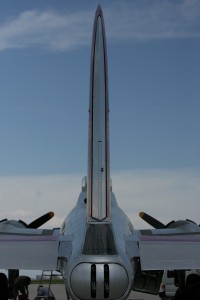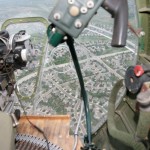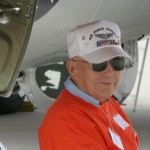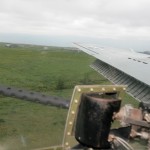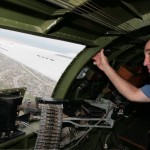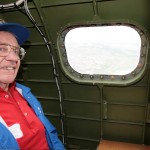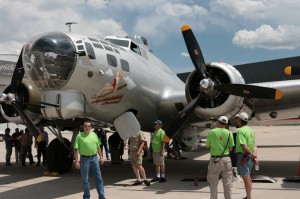
Volunteer Bobby Baumgartner in front of Aluminum Overcast on Signature Flight Support’s ramp at Centennial Airport.
By Reggie Paulk
Sitting in the sideways-facing sling seat on the starboard rear of the B-17, the anticipation is almost unbearable as passengers talk excitedly about the unfolding adventure. After securely clasping the military-style harness, there’s a brief moment to get a sense of the surroundings: olive drab-painted aluminum skin, stringers, Browning machine guns, control cables, plywood floor panels and little else. It has no insulation to give a sense of thickness to the fuselage or to dampen the roar of the four Wright Cyclone engines about to perform their start-up ritual. In fact, nothing’s on the airplane that’s not necessary for war.
A glance forward reveals the top of the ball turret and the structural post that suspends it. An awkward catwalk wraps around the turret, and past that is a narrow passageway to radar and radio stations. Further forward, through a narrow slit that is the bomb bay catwalk, are the shoulders of the pilots readying the bird for flight. In the immediate vicinity, Browning machine guns perch through square Plexiglas portals on each side of the aircraft. These are the waist guns.
The B-17’s radial engines use avgas, and the familiar smell of it lingers in the air. Knowing the airplane can carry 1,700 gallons of the stuff, it’s not difficult to imagine that an engine fire would be terrifying. As the hard reality of what this aircraft is all about begins to sink in, the engines spin to life, barking and belching blue smoke. Now the slightly acrid scent of engine exhaust makes its way in. With all four engines and their combined 36 cylinders idling, the airplane rattles, shakes and shimmies. Nothing happens very fast though, because those big radials have to warm their oil to operating temperature before the airplane can get underway.
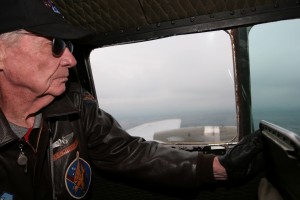
Mitch Mischler, 8th Air Force veteran and survivor of 25 missions, monitors the progress of the B-17, Aluminum Overcast.
Suddenly, a rush of panic sweeps over you. Sitting here in this shuddering beast, it’s no longer 2007; it’s 1944, and this plane is on a bombing mission over Germany. These guns are the only defense against the German Luftwaffe, and the thin skin of the bomber is a stark reminder of vulnerability. It seems that if you step too hard, you can pierce right through it. It takes a conscious effort to come back to the present and try to remember that this is a pleasure flight.
An increase in noise and shaking reveals that the airplane’s about to begin taxiing toward the runway. The airplane moves forward, and then jolts quickly to a squealing stop as the pilots perform a brake check. Once more, the airplane moves forward, and once more, a sudden jerk to a stop to again check brakes. Taxiing in a B-17 isn’t a smooth process. This big taildragger requires decisive and judicious use of brake in order to maneuver. The airplane makes its way slowly toward the runway, squeaking and jerking its way there.
Once at the run-up area, the throttles are advanced for systems checks, and the airplane begins to show its true power. The combined 4,800 horsepower from the four engines creates a powerful airflow over the flying surfaces, and the airplane shimmies in a much different way now. Back to idle, and takeoff is moments away.
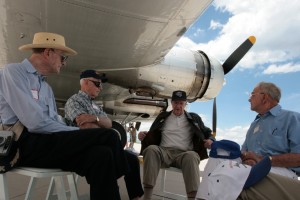
Members of the 8th Air Force Historical Society swap flying stories in the shade of the B-17’s wing.
The airplane moves forward, and for the first time, the realization hits that the cables passing overhead control the tail wheel and flying surfaces. Their small movements are in unison with the twists and turns of the airplane, and it’s easy to imagine how a bullet could slice right through them. The airplane turns onto the runway, a cable slides overhead to lock the tail wheel, and the throttles go to full power.
The acceleration at takeoff is unexpected. The B-17 looks ungainly, and it’s difficult to imagine how an airplane that looks like the B-17 could accelerate so rapidly, but it does. If the acceleration’s unexpected, so too is the noise. Twelve propeller blades spinning at nearly the speed of sound create a cacophony that vibrates to the very soul. The sound beats in the chest and resonates throughout every fiber of the aircraft and crew. Huge goose bumps sprout from the arms. The hair on the back of your neck stands at attention, and chills run down your spine. You’re flying on a B-17!
For many, the B-17 symbolizes the pinnacle of American might during World War II. Grainy black and white film reels showing fleece-clad waist gunners manning their .50 caliber Browning machine guns are all too familiar. So too are images of the final moments of doomed aircraft and crews.
Some people have had the privilege to speak with veterans who crewed the B-17. Their tales of flack and enemy fighters are almost surreal, but it can be difficult for the listener to relive those experiences without the proper perspective. In order to begin to fathom their experience, it’s necessary to take a ride on a time machine. Enter Aluminum Overcast.
The Army Air Corps took delivery of Aluminum Overcast in May 1945. She’s a B-17G-VE: one of more than 12,000 B-17s built during the war and one of only about 15 examples flying today. Her delivery date meant that she’d never see the ravages of war and is probably a good reason why she remains in service today. After being sold into the civilian market in 1946, she hauled cargo and performed other duties befitting a military surplus aircraft.
In 1978, after more than 20 years of hard labor, a group of people dedicated to preserving the heritage of these beautiful aircraft rescued her. After confronting the daunting financial challenge of maintaining and restoring the old bird, the group donated the airplane to EAA in 1983. After 10 years and countless hours of volunteer effort, Aluminum Overcast returned to her former glory.
With restoration complete, EAA decided to send Aluminum Overcast on tour around the nation, to expose people to the heritage that is the B-17. In addition to giving ground tours, a privileged few participate in an actual “mission.” This year, as part of what EAA has dubbed the “Keep It Flying” tour, the airplane made a stop at Centennial Airport, from June 15-18. It was one of nearly 60 stops planned for the 2007 season.
Parked in front of Signature Flight Support’s hangar, the B-17’s well hidden. It’s nearly impossible to see her without going through the hangar and out on the tarmac. That’s a good thing, because the airplane really needs to be admired up close. Stepping from the darkness of the hangar into the blinding noon sun, it takes a while for the eyes to adjust. But as soon as they take in the silvery tones of that majestic bird, the heart flutters. If you have any connection to WWII, the airplane will grab you in a profound manner. Touching her skin and seeing her proportions in real life gives a sense of what she must have been to the crews that manned her. In her day, she was the biggest airplane many of her crews had ever seen.
No discussion about Aluminum Overcast would be complete without mentioning the volunteers behind “Keep It Flying.” At every stop, dozens of volunteers care for Aluminum Overcast and her guests. They give freely of their time so that others may enjoy the American heritage. This is no truer than during her Denver stop.
This year, Wings Over the Rockies Air and Space Museum recruited volunteers who proudly wore orange and green volunteer shirts as they ensured a successful tour. If you think about what it would cost to employ the dozens of people needed to operate an activity like this safely, it quickly becomes apparent that this is one B-17 that doesn’t fly on money alone. It’s carried aloft on the backs of people who give of themselves so that others may experience something as inspiring as history in the flesh. The cost of a tour, or even a 30-minute mission, is a token to what we’re given in return. Those volunteers deserve special appreciation. You may have missed this tour, but Aluminum Overcast will be back next year.
For more information about Aluminum Overcast, visit [http://www.b17.org]. For more information about Wings Over the Rockies, visit [http://www.wingsmuseum.org].
- This was the view from the bombardier’s position during flight.
- Casey Clark originally trained in the ball turret during World War II, but never had to serve in it.
- Aluminum Overcast comes in on short final to Centennial Airport.
- Reggie Paulk Sr. ponders the view from the port waist gunner’s position of the B-17.
- Robert Ganew, in the radio room, crewed the ball turret during WWII.
- This view from Aluminum Overcast’s top turret shows the Denver Tech Center.













